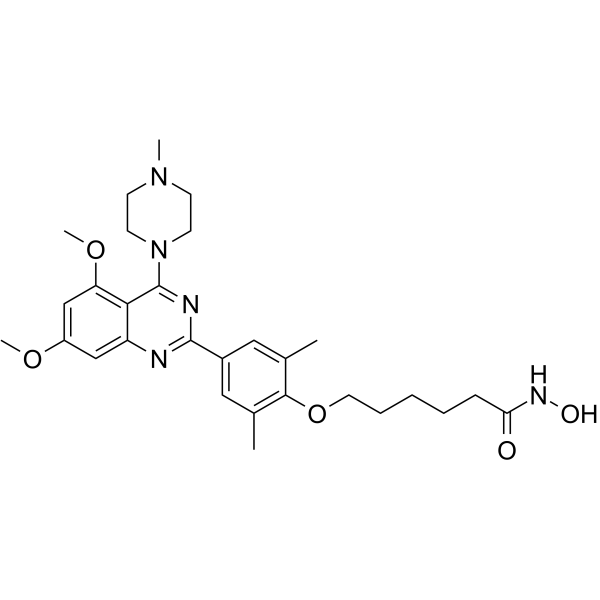HDAC-IN-36

HDAC-IN-36 structure
|
Common Name | HDAC-IN-36 | ||
|---|---|---|---|---|
| CAS Number | 2482992-54-9 | Molecular Weight | 537.65 | |
| Density | N/A | Boiling Point | N/A | |
| Molecular Formula | C29H39N5O5 | Melting Point | N/A | |
| MSDS | N/A | Flash Point | N/A | |
Use of HDAC-IN-36HDAC-IN-36 (compound 23 g) is an orally active and potent HDAC (histone deacetylase) inhibitor, with an IC50 of 11.68 nM (HDAC6). HDAC-IN-36 promotes apoptosis, autophagy and suppresses migration. HDAC-IN-36 shows anti-tumor and anti-metastatic activity, and can be used for breast cancer research[1]. |
| Name | HDAC-IN-36 |
|---|
| Description | HDAC-IN-36 (compound 23 g) is an orally active and potent HDAC (histone deacetylase) inhibitor, with an IC50 of 11.68 nM (HDAC6). HDAC-IN-36 promotes apoptosis, autophagy and suppresses migration. HDAC-IN-36 shows anti-tumor and anti-metastatic activity, and can be used for breast cancer research[1]. |
|---|---|
| Related Catalog | |
| Target |
HDAC6:11.68 nM (IC50) HDAC10:13.24 nM (IC50) HDAC3:79.17 nM (IC50) HDAC1:86.93 nM (IC50) HDAC2:97.32 nM (IC50) HDAC8:378.2 nM (IC50) HDAC4:>1000 nM (IC50) HDAC5:>1000 nM (IC50) HDAC7:>1000 nM (IC50) HDAC9:>1000 nM (IC50) HDAC11:>1000 nM (IC50) |
| In Vitro | HDAC-IN-36 (compound 23 g) (0-10, 24 h) exhibits good antiproliferative activity in MDA-MB-231 cells, promotes the acetylation of α-Tubulin and HSP90[1]. HDAC-IN-36 (0-10, 24 h) induces apoptosis in MDA-MB-231 cells in a dose-dependent manner, and mainly induces mitochondrial-dependent apoptosis[1]. HDAC-IN-36 (0-10, 24 h) inhibits MDA-MB-231 cells migration in a dose-dependent manner, increases the expression of E-cadherin and decreases the expression of MMP-2 obviously[1]. HDAC-IN-36 (0-10, 24 h) induces noteworthy autophagy, increases the expression of Beclin1, LC3II and decreases the expression of SQSTM1/p62[1]. Cell Viability Assay Cell Line: MDA-MB-231 cells[1] Concentration: 0, 2.5, 5, 10 μM Incubation Time: 24 h Result: Exhibited good anti-proliferative activity in MDA-MB-231 cells, with IC50 of 1.32 ± 0.13 μM, increased the acetylation level of intracellular proteins, and promoted the acetylation of α-Tubulin and HSP90. Apoptosis Analysis Cell Line: MDA-MB-231 cells[1] Concentration: 0, 2.5, 5, 10 μM Incubation Time: 24 h Result: Induced apoptosis in MDA-MB-231 cells in a dose-dependent manner. Cell Autophagy Assay Cell Line: MDA-MB-231 cells[1] Concentration: 0, 2.5, 5, 10 μM Incubation Time: 24 h Result: Induced noteworthy autophagy with increased aggregation of LC3 puncta. Western Blot Analysis Cell Line: MDA-MB-231 cells[1] Concentration: 0, 2.5, 5, 10 μM Incubation Time: 24 h Result: Mainly induced mitochondrial-dependent apoptosis, up-regulated the expression of Bax and downregulated the expression of Bcl-2, and increased the cleavage of caspase3, caspase8 and caspase9; increased the expression of E-cadherin and decreased the expression of MMP-2 obviously; increased the expression of Beclin1, LC3II and decreased the expression of SQSTM1/p62. |
| In Vivo | HDAC-IN-36 (compound 23 g) (Zebrafish tumor xenograft model; 0-5 μg/mL, 3 days) shows potent anti-tumor and anti-metastatic activity, and improves in vivo anti-tumor efficacy[1]. HDAC-IN-36 (Beagles, 20 mg/kg, Orally, once) shows a significant improvement in pharmacokinetic parameters[1]. Pharmacokinetic Parameters of HDAC-IN-36 in male Beagles[1]. Parameters 23g (20 mg/kg) T1/2 (h) 1.24 ± 0.21 Tmax (h) 0.79 ± 0.33 Cmax (μg/L) 120.36 ± 15.53 AUC0-t (μg/L∗h) 1275.35 ± 70.17 AUC0-∞ (μg/L∗h) 1289.40 ± 88.91 Animal Model: Zebrafish (MDA-MB-231-derived xenograft model, Wild-type AB strain)[1] Dosage: 0, 2.5, 5 μg/mL Administration: 3 days Result: Inhibited tumor formation and migration in a dose-dependent manner, and improved in vivo anti-tumor efficacy. Animal Model: Beagles (female, 8-10 kg, n = 4)[1] Dosage: 20 mg/kg (dissolved 0.5% sodium carboxyl methyl cellulose (CMC-Na) aqueous solution) Administration: Orally, once (Pharmacokinetic Analysis) Result: Showed a significant improvement in pharmacokinetic parameters with T1/2 value of 1.24 h. |
| References |
| Molecular Formula | C29H39N5O5 |
|---|---|
| Molecular Weight | 537.65 |